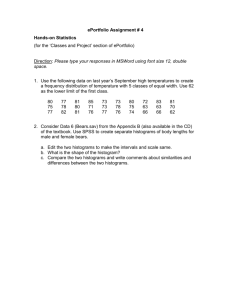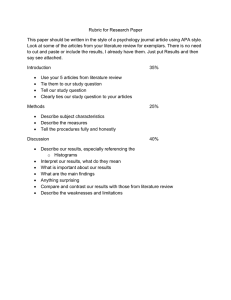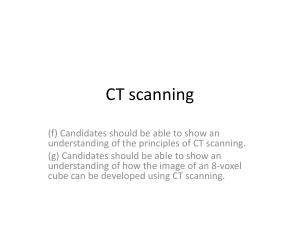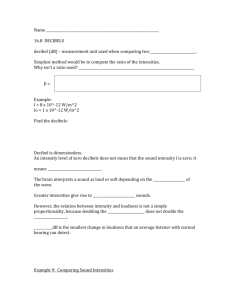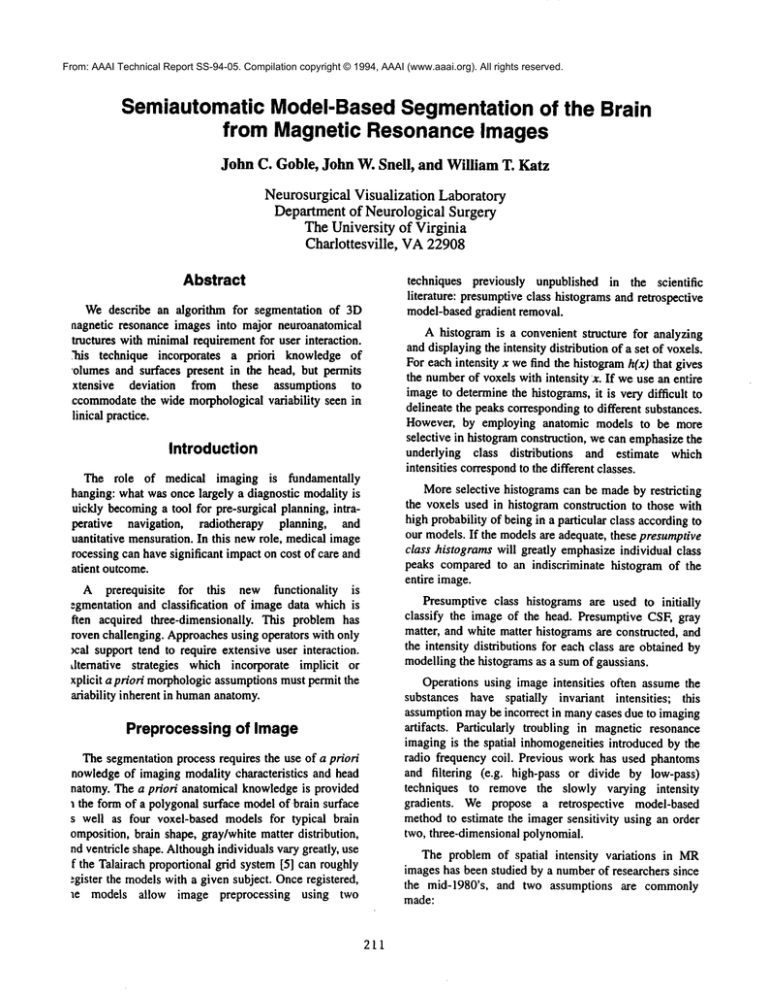
From: AAAI Technical Report SS-94-05. Compilation copyright © 1994, AAAI (www.aaai.org). All rights reserved.
SemiautomaticModel-BasedSegmentationof the Brain
from Magnetic ResonanceImages
John C. Goble, John W. Snell, and William T. Katz
NeurosurgicalVisualization Laboratory
Departmentof Neurological Surgery
TheUniversity of Virginia
Charlottesville, VA22908
Abstract
Wedescribe an algorithm for segmentation of 3D
nagnetic resonance images into major neuroanatomical
tructures with minimalrequirement for user interaction.
~his technique incorporates a priori knowledge of
¯ olumes and surfaces present in the head, but permits
xtensive deviation
from these assumptions to
ccommodatethe wide morphological variability seen in
linical practice.
Introduction
The role of medical imaging is fundamentally
hanging: what was once largely a diagnostic modality is
uickly becominga tool for pre-surgicai planning, intraperative navigation, radiotherapy planning, and
uantitative mensuration. In this newrole, medical image
recessing can have significant impact on cost of care and
atient outcome.
A prerequisite
for this new functionality
is
egmentation and classification of image data which is
ften acquired three-dimensionally. This problem has
roven challenging. Approachesusing operators with only
~cal support tend to require extensive user interaction.
alternative strategies which incorporate implicit or
xplicit a priori morphologicassumptionsmust permit the
ariability inherent in humananatomy.
techniques previously unpublished in the scientific
literature: presumptiveclass histograms and retrospective
model-basedgradient removal.
A histogram is a convenient structure for analyzing
and displaying the intensity distribution of a set of voxels.
For each intensity x we find the histogramh(x) that gives
the numberof voxels with intensity x. If we use an entire
imageto determine the histograms, it is very difficult to
delineate the peaks correspondingto different substances.
However, by employing anatomic models to be more
selective in histogram construction, we can emphasizethe
underlying class distributions
and estimate which
intensities correspondto the different classes.
Moreselective histograms can be madeby restricting
the voxels used in histogram construction to those with
high probability of being in a particular class according to
our models. If the modelsare adequate, these presumptive
class histograms will greatly emphasizeindividual class
peaks compared to an indiscriminate histogram of the
entire image.
Presumptive class histograms are used to initially
classify the image of the head. Presumptive CSF, gray
matter, and white matter histograms are constructed, and
the intensity distributions for each class are obtained by
modelling the histograms as a sumof gaussians.
Operations using image intensities often assume the
substances have spatially invariant intensities; this
assumption maybe incorrect in manycases due to imaging
artifacts. Particularly troubling in magnetic resonance
imaging is the spatial inhomogeneities introduced by the
radio frequency coil. Previous work has used phantoms
and filtering (e.g. high-pass or divide by low-pass)
techniques to remove the slowly varying intensity
gradients. Wepropose a retrospective
model-based
methodto estimate the imager sensitivity using an order
two, three-dimensional polynomial.
Preprocessing of Image
The segmentation process requires the use of a priori
nowledgeof imaging modality characteristics and head
natomy. The a priori anatomical knowledgeis provided
1 the form of a polygonal surface modelof brain surface
s well as four voxel-based models for typical brain
omposition, brain shape, gray/white matter distribution,
nd ventricle shape. Althoughindividuals vary greatly, use
f the Talairach proportional grid system [5] can roughly
.~gister the modelswith a given subject. Onceregistered,
~e models allow image preprocessing
using two
The problem of spatial intensity variations in MR
images has been studied by a numberof researchers since
the mid-1980’s, and two assumptions are commonly
made:
211
Active Surfaces
!) The observed intensities /obs(/~) ---- !(~)
product of the RF signals generated by the relaxing
protons, l~e 0), and the sensitivity profile S(~) of the
coil used to detect the generatedsignals:
I oh, 0~) = SO)" I~, @)
Analysis of the presumptive class histograms allows
the image to be automatically broken into foreground and
backgroundregions corresponding to head/brain and air/
bone/cerebrospinal fluid respectively. The head and brain
are typically spatially connected within the foreground
region and must be separated by selectively breaking
theses connections. This task is performed by the
application of an active surface template, whichelastically
modelsthe outer surface of the brain and spinal cord (see
Figure 1.).
(l)
2) Thesensitivity profile S(13) varies slowly relative
the higher spatial frequency components of anatomical
object borders.
Removalof the gradient, then, is simply a matter of
determining true~)
from Iobs~). Weuse the a priori
I
knowledgeprovided by the registered modelsand treat the
imaged brain as our phantom. Rather than estimating
S~) by using a phantom, iowpassed image, or userdefined points, weestimate le~e (/~) for likely brain voxels
in a subsampledfashion, calculate an averaged sensitivity
profile at each point in the subsampledgrid, and then fit a
polynomialto the averagedsensitivities. Since the voxelbased models are used to select the data points, user
interaction is reduced to the initial registration of the
imageto Talalrach space.
The surface model is based on the physically-based
deformablemodelsdescribed in [6.]. The active surface is
the three-dimensionalanalog of the active contour. It is an
energy minimizing spline which is characterized by a set
of intrinsic and extrinsic constraints. The intrinsic
constraints govern the material properties of the surface,
while the extrinsic constraints link the surface to the image
data through "forces" which deform it. The equation of
motion is given by
Each subvolume ~ has some number nq of voxels Vq
which are considered likely "brain" elements by the
registered voxel-based brain composition model. We
calculate the following for each subvolume ~ only if
2,)
r(o+
-" Lt )
nq>O:
whereobs
7 (q) is the avei’age of the observed intensities
within a subvolume;
lt~e~)
= E [l’tgmMga~)
8P
f(v)= 8-’~
+ gwmMwa~)]/% (3)
Jobs
=
~
I oO)
(6)
The image potential function P(v) may be defined
using the imageintensity alone as
wherelt~¢ (~) is the averageof the expectedintensities for
the subvolume,l.t g mand I.twm are the centers
of the gray
.~
n.
and white matter modelledgaussians, Mg
(t~)
and
d
d (/ ~)
are the gray and white matter probabilities at a given voxel
position/~; and
~(~)
ta)J
where wI and w2 determine the elasticity and stiffness of
the surface respectively. Currently, these coefficients must
be determined empirically. The surface is linked to the
imagedata by the extrinsic forces defined as
(2)
L,,,(O
(5)
P (v)
= Wlinel
(V) - WeagelVl (v) 12
(7)
wherel(v) is the imageintensity function. The coefficient
Wline controls the attraction of the surface to ridges or valleys in the image intensity function while Wedg
e controls
the attraction of the surface to areas of high intensity gradient(edges).
(4)
Wehave developed an extrinsic force formulation
based on mathematical morphologyin order to keep the
active surface from becomingtrapped in the interior of the
brain. Our image potential function is based on a vector
distance transform(VDT) [3] of the foreground region
which has the effect of reducing unwantedlocal minima
which typically occur in Equation (7). The gradient of the
VDTalways points toward the nearest foreground
whereS(~) is the estimated sensitivity at
Wecan then fit a second-order three-dimensional
polynomial
~) to S(~) using singular
value
decompositionto find the best least-squares approximation
[4]. Since our fit polynomial~(~) describes a continuous
surface, we can compute the corrected intensity at any
voxel ~ of the imageas ltrue~) --- /(/~) / ’I((K ¯ ~)
is used to mapvoxels to subvolumes.
212
~oundaryand therefore tends to restore surfaces from the
nterior of the foreground.
clinical practice. Therefore, the segmentation process,
while nearly automatic for "normal" images, should allow
user labelling to override model-based labelling when
pathology is encountered.
In order to solve the systemgiven by Equation(5), the
Iomain is discretized with equal spacing h between the
,,rid points and the derivatives of the Laplacian and
,iharmonic parts of Equation (5) are approximated
inite differences. The system maywritten in matrix form
After determination of the brain boundaries using the
active surface method, all foreground and background
areas are brokeninto regions using watershedanalysis [7].
Foregroundareas are broken into regions using watershed
analysis on image gradients while the background areas
are split by watershed analysis of distances from the
foreground.
S
AV = F
(8)
nd because A is large and sparse we have used the simple
;auss-Seidei iterative solution method, lagging the nonnear terms in F [1]. The iteration process is stopped
~hen the maximumnode movement falls below some
lreshold, whichis typically on the order of the voxel size.
rgureI:
After splitting of an image into numerousregions, one
wouldlike a data structure whichcompactlyrepresents the
spatial relationships of the regions and allows efficient
analysis of the represented regions. The region adjacency
graph (RAG)is a popular data structure satisfying these
requirements. In a RAG,regions are represented as nodes
(or vertices or points) and the adjacencyof two regions
represented by an edge (or arc)between the two
corresponding nodes.
TwoRAGsare created - one for the background area
and one for the foreground area. Adjacencies between
foreground and background regions are not included in
either graph. The next step mergesthe different regions
into coherent 3D objects. Within Talairach space,
ufiiversally present head structures like the brain and
ventrieular system are easily localized. For these
structures, anatomical models can automatically provide
the initial labelling of "core" nodeslocated in areas almost
always occupied by a particular structure. Howeverin
clinical settings, a numberof unexpected objects (e.g.
tumors, cysts) can occur in a variety of locations. In order
to segment these objects, the voxel-based models must be
supplementedby user labelling. This requirement is met
by our twostage approachof (I) initial labelling followed
by (2) prioritized growthof structures.
Theactive surfacetemplateof the outerbrain end
spinal cord $ur/acee.
The major substructures of the brain are modeled
tdepcndently by separate active surfaces. These
Jbsurfaces are connected by enforcing mutual boundary
~nditions alone adjoining edges. The resulting surface
Iodel is comprised of approximately 80 thousand nodes
nd requires 3-4 minutes of computation on an HPApollo
DOseries workstation. The equilibrium configuration of
le active surface modelis then used to separate the brain
¯ ore the foregroundregion of the image.
Thenodesare initially labelled by either the registered
anatomic models or a knowledgeable user. From these
initially labelled core nodes, we slowly grow our target
structures towards the more ambiguousborder areas using
a prioritized growth algorithm. The prioritized growth
algorithm works sequentially through an ordered list of
unlabeled nodes. The priorities
(which determine
ordering) are computed, in part, by the strength of
regions connections to previously labelled neighboring
regions. Labelling halts whenall nodes have been visited;
therefore, the algorithm is guaranteed to terminate after
visiting each unlabeled node once.
Prioritized Growth
While model-based knowledgeis essential to making
.’gmentation more automatic, current limitations in
3mputational power and memory prevent any fully
atomated model-based segmentation system from
~rrectly identifying the variety of imagesencounteredin
Figure (3) demonstratesthe results of the prioritized
growth algorithm on a patient with an unrecognized
subdural hematoma.
213
Results
References
The three-dimensional magnetic resonance data sets
used in our experiments were acquired with the 3D MPRAGEpulse sequence[2] on a 1.5 T Siemens Magnetom.
This sequence employeda 180 degree inversion pulse to
produce a strongly Tl-weighted image with an inversion
time of 500 ms. The 3D image was acquired with a matrix
of 256x256x128to give a voxel size of 1.0xl.0xl.3 nun.
The acquisition time was 11 minutes.
Golub,
G. andJ. Ortega,
Scientific
Computing
and
Differential
Equations,
Academic
Press,
1991.
.
.
Cadaver studies were performed to validate the
segmentation results. The brain was segmented from MR
images of whole cadaver heads and compared with images
of the brain after dissection (Figure 3). Segmented
volumes compare with actual volume measurements
within 5%.
.
.
Conclusions
.
We have described a fast and accurate brain
segmentation method that provides a basis for 3D
visualization and surgical planning. The methodpermits
3D models of patient anatomy to be constructed within
minutes of image acquisition,
making 3D image
acquisition and visualization clinically practical.
. Figure2:
Thepdorttized growth algorithmhss.
beenused to segmenta user-aenn.ea
object within the brain (hematOma).
Figure 3:
.
Mugler, HI, J.P. and J.R. Brookeman,"ThreeDimensional Magnetization-Prepared Rapid
Gradient-Echo Imaging (3D MP-RAGE),"Mag Res
Med, 15, 152-157, 1990.
Mullikin, JC., "The Vector Distance Transformin
Twoand Three Dimensions," CVGIP,53, 76-87,
1991.
Press WH,SATeukolsky, WTVetterling and BP
Flannery, Numerical Recipes in C. Cambridge:
CambridgeUniv. Press, 1992.
Talairach J and P. Toumoux,Co-PlanarStereotaxic
Atlas of the HumanBrain. NewYork: Georg Thieme
Vedag, 1988.
Terzopoulos, D., A. Witkin, and M. Kass.,
"Constraints on Deformable Models: Recovering 3D
Shape and Nonrigid Motion," Artificial Intelligence,
36, 91-123, 1988a.
Vincent L. and P. Soille, "Watershedsin Digital
Spaces: An Efficient Algorithm Based on Immersion
Simulations." 1EEETrans Pattern Anal Machine
lntell, 13: 583-598,1991.
Comparison
of automatedsegmentationwith actual brain dissection. The
top rowshowsreconstructions of the segmented
brain in situ. Thebottom
row snowsthe equivalent reconstructions of the imageddissectedbrain.
214

